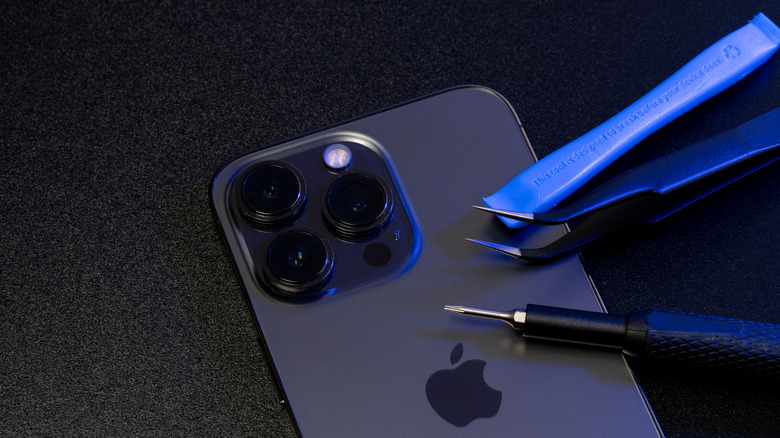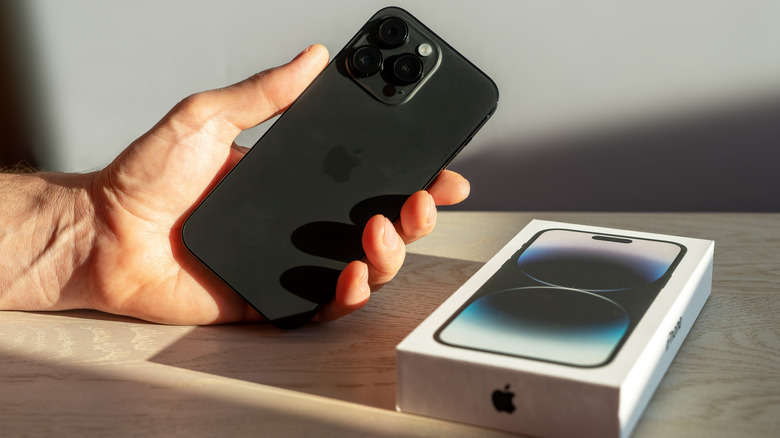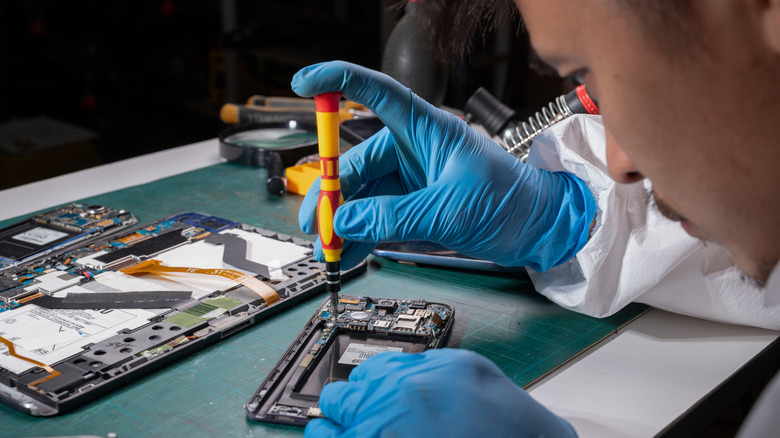The Most Difficult Modern iPhone To Repair (According To iFixit)
If you've been following the right-to-repair debate, you already know Apple's been catching heat for years. Repair pros, tinkerers, and everyday iPhone owners alike accuse the company of making its devices harder to fix than they need to be. And if you needed proof, iFixit has been keeping score, literally. The teardown experts publish repairability ratings for phones, giving each one a score from one to 10, ranging from "bomb defusal" to "Saturday DIY project." Those scores are based on a whole checklist of criteria (we'll break them down on the last slide), but the core idea is simple: a truly repairable device should be fixable by anyone, not just the manufacturer or its "authorized" techs.
Phones like the Shiftphone 6m or the Fairphone 5 prove this is not a pipe dream, earning scores of nine and 10 respectively thanks to modular parts and repair-friendly designs. Recent iPhones land somewhere in the middle: not a lost cause, but not exactly user-friendly either. But among the lineup, one model — the iPhone 14, especially the Pro variant — stands out for all the wrong reasons.
Why the iPhone 14 is so hard to repair
The iPhone 14 didn't bomb iFixit's scale because its hardware was overly complex. Ironically, Apple redesigned it to be easier to crack open. The real problem lies in the software. Apple's "parts pairing" system requires that new components be registered and authenticated by Apple's servers. In practice, this means that even if you swap a battery, display, or camera with a genuine Apple replacement, the phone may disable features or flood you with warnings unless Apple's own software "authorizes" the repair. It's like replacing a car tire only to be told the engine won't start unless the dealership approves it. You really shouldn't need Apple's permission to install a new screen or battery on a phone you already own.
This is why the entire iPhone 14 lineup (base, Plus, and Pro) ended up with a measly four out of 10 repairability score. It's an ironic verdict because, at launch, iFixit initially rated the iPhone 14 a more generous seven out of 10. It even called it "the most repairable iPhone in years" before backtracking once the software shackles came to light, which is the ugly reality about iPhone repairs. That, plus it is both difficult and expensive to replace the rear glass on the Pro models.
For context, a four out of 10 doesn't mean "unfixable," but it does mean "harder than it needs to be." So despite its friendlier internals, the iPhone 14s still earn the crown as the most frustrating modern iPhone to repair. In contrast, the newer iPhone 15 and 16 models jumped back up to seven out of 10, thanks to a design that separates screen repairs from rear access and uses screws and clips for easier reassembly.
How it was scored
iFixit's repairability ranking follows a strict rubric. Most of the score (a hefty 80%) comes down to design for repair. In plain terms: how easy is it to open a device without breaking it, can you do it with cheap/common tools, and are the critical parts actually accessible? A truly repairable phone should be one you can open, fix, and close again without drama. The remaining 20% is split evenly between repair instructions and parts availability. On the manuals front, the best ones don't just tell you where the screws are; they include tool lists, parts lists with proper IDs, exploded diagrams, troubleshooting steps, and even board schematics. Without a manual, a device's ceiling drops to a nine out of 10.
Then there are parts. It's not enough to say replacements exist; they have to be officially available for the public to buy, not locked behind an "authorized dealer" wall. Aftermarket parts are great (sometimes better), but OEMs only score points when they open their own catalog. Range matters too: a single replacement battery won't cut it. Ideally, you'd be able to piece together an entire phone from what's on offer. And pricing counts — if a part costs more than 25% of a new phone, most people won't bother fixing it.
Apple technically "offers" all this through its Self Service Repair program — manuals, parts, even pro-grade tools you can rent. But the tools are expensive and overkill, parts are tightly serialized to your device, and the process is so convoluted that most people give up before they start. That's why the 14 Pro, shiny as it is, still earns a failing grade.


